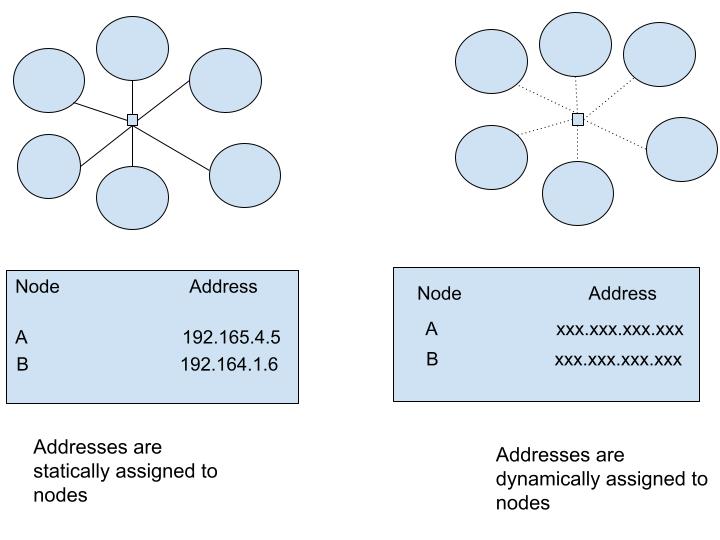1. 概述
在网络中,数据是以数据包的形式传输的。如果没有合理地引导和控制这些数据包的传输路径,可能会导致网络拥塞甚至瘫痪。因此,路由机制应运而生,它通过为数据包选择合适的传输路径来提升网络通信的效率。
路由主要分为两种类型:静态路由和动态路由。本文将详细对比它们之间的差异,帮助你更好地理解各自适用的场景。
2. 什么是路由?
路由是指为数据包建立传输路径的过程。 通俗来说,就是从源节点到目标节点之间选择一条最优路径进行数据传输。
计算机网络主要由两个部分组成:
- 节点(Nodes):即网络中的设备(如路由器、主机等)
- 链路(Paths or Links):连接节点之间的物理或逻辑通道
在复杂的互联网络中,两个节点之间可能有多条通信路径。路由的作用就是从中选出一条最优路径,以确保通信的高效和稳定。
3. 路由的类型
如前所述,路由分为两种类型:静态路由和动态路由。它们的核心区别在于路由器如何生成和维护其路由表:

3.1 什么是静态路由?
静态路由是指由网络管理员手动配置和维护的路由表。管理员需要为每一条路径手动添加路由条目。
✅ 适用场景:适用于网络结构简单、拓扑不变或变化很少的小型网络。
3.2 什么是动态路由?
动态路由是通过路由器之间运行的路由协议自动创建和更新路由表的一种机制。当网络拓扑发生变化时,动态路由可以自动调整路径。
✅ 适用场景:适用于大型、结构复杂、经常变化的网络环境。
4. 静态路由与动态路由的区别
下面从多个维度来对比这两种路由方式的差异:
4.1 路由协议
路由协议是一组规则,用于路由器之间交换信息,以便选择最优路径。
- 静态路由:不依赖任何路由协议。
- 动态路由:使用如 RIP、IGRP(距离矢量协议)或 OSPF、IS-IS(链路状态协议)等协议自动调整路由。
4.2 路由表条目
当某个路由器发生故障时,两种路由方式处理方式不同:
- 静态路由:需要管理员手动重新配置路由并更新路由表。
- 动态路由:路由器通过协议自动计算出替代路径,并更新路由表。
4.3 网络规模
- 静态路由:适合小型网络,因为手动配置简单,但随着网络规模增大,维护成本会显著上升。
- 动态路由:适合大型网络,能自动发现并维护多条路径,适应网络变化。
4.4 链路故障处理
链路故障是指节点之间的连接中断。
- 静态路由:一旦路径中断,整个通信可能失败,除非手动配置新路径。
- 动态路由:可以自动切换到备用路径,不影响整体通信。
✅ 踩坑提醒:在高可用系统中,如果使用静态路由而未配置冗余路径,一旦链路中断,可能导致服务不可用。
4.5 安全性
- 静态路由:安全性更高,因为不会在整个网络中广播路由信息。
- 动态路由:安全性较低,因为它需要在整个网络中共享完整的路由表信息。
⚠️ 建议:在高安全要求的环境中,建议结合动态路由与认证机制来提升安全性。
4.6 路径变更
- 静态路由:路径不会自动变更,需要手动干预。
- 动态路由:能根据网络状况自动调整路径,适应性强。
5. 总结
本文介绍了路由的基本概念及其两种主要形式:静态路由和动态路由。我们从多个维度对比了它们的优缺点和适用场景:
| 对比维度 | 静态路由 | 动态路由 |
|---|---|---|
| 路由协议 | 不使用 | 使用协议 |
| 路由表维护 | 手动 | 自动 |
| 网络规模 | 小型网络 | 大型网络 |
| 链路故障处理 | 无法自动恢复 | 可自动切换路径 |
| 安全性 | 较高 | 较低 |
| 路径变更 | 需手动配置 | 自动适应变化 |
✅ 总结建议:
- 小型、结构稳定网络 ➡️ 推荐使用静态路由
- 大型、拓扑频繁变化网络 ➡️ 推荐使用动态路由
选择合适的路由方式,是保障网络稳定性和高效性的关键一步。